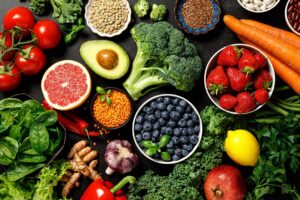 Do you want to increase your intake of beneficial vegetables for type 2 diabetes but don’t know where to start? While we all have a tendency to go for the greens, it might be time to broaden our horizons and learn more about purple vegetables and tubers.
Do you want to increase your intake of beneficial vegetables for type 2 diabetes but don’t know where to start? While we all have a tendency to go for the greens, it might be time to broaden our horizons and learn more about purple vegetables and tubers.
Not only are they beautiful in color, but they also provide many nutritional benefits, one of which is their anti-diabetic properties. In this blog post, we’ll explore why purple kitchen staples could be an important part of an overall healthy diet and lifestyle if you want or need to manage diabetes!
Advertisement
Anthocyanins are a class of water-soluble plant pigments found in berries, fruits, and vegetables with vibrant colors such as red, purple, and blue. These pigments have strong antioxidant properties that help protect cells from damage due to environmental pollutants like smoke and radiation. Anthocyanins may also boost the immune system, help reduce inflammation, and offer heart health benefits.
Studies have linked anthocyanins to positive effects on vision and cognitive function, while they’re thought to contribute to a healthier digestive tract too. In short, anthocyanins are naturally occurring substances providing an array of potential health benefits.
It is important to understand what fruits and vegetables contain a significant number of acylated anthocyanins as opposed to nonacylated anthocyanins. For example, purple potatoes, purple sweet potatoes, radishes, purple carrots, and red cabbages contain acylated anthocyanins, whereas bilberries and mulberries contain mostly nonacylated anthocyanins.
Acylated anthocyanins are not absorbed well in digestion, which may not sound like a good thing. However, paired with their probiotic properties, they can help to reduce the risk of diabetes more effectively than nonacylated anthocyanins.
A new review article comparing the results of anthocyanins showed that acylation affects how anthocyanins are absorbed and metabolized in addition to changing physical and chemical properties. The acylated anthocyanins were also found to be more effective antioxidants than the nonacylated anthocyanins, and they may also improve the absorption of necessary nutrients through the intestinal barrier. Furthermore, the acylated anthocyanins suppress pro-inflammatory pathways, maintain gut microbiota homeostasis, and modulate glucose and lipid metabolisms.
How Do Acylated Anthocyanins Work?
Advertisement
Acylated anthocyanins work by traveling through the body from the upper gastrointestinal tract to the colon, where the gut microbiota metabolizes them. Different glucose transporters are responsible for the absorption of acylated and nonacylated anthocyanins. The review also found that acylated and nonacylated anthocyanins have different impacts on the enzymes involved in metabolism.
So, for those concerned about type 2 diabetes and looking for a healthy and nutritious way to help prevent the disease, anthocyanin-rich fruits and vegetables may be the key! However, while consuming these types of foods can be helpful in reducing the risk of diabetes, many other lifestyle changes are needed to ensure healthy blood sugar. This list includes getting regular exercise, reducing processed and packaged foods and getting essential vitamins and nutrients the body requires to stay healthy.
Maintaining Healthy Blood Sugar Levels
Healthy Blood Sugar Support can help maintain healthy blood sugar levels using a number of ingredients that have been shown in clinical studies. The health benefits of this unique formula include supporting blood sugar metabolism and promoting healthy cholesterol and glucose levels already within the normal range. Healthy Blood Sugar Support can also help to reduce excessive hunger or increased appetite, fatigue, and blood glucose spikes after meals.
